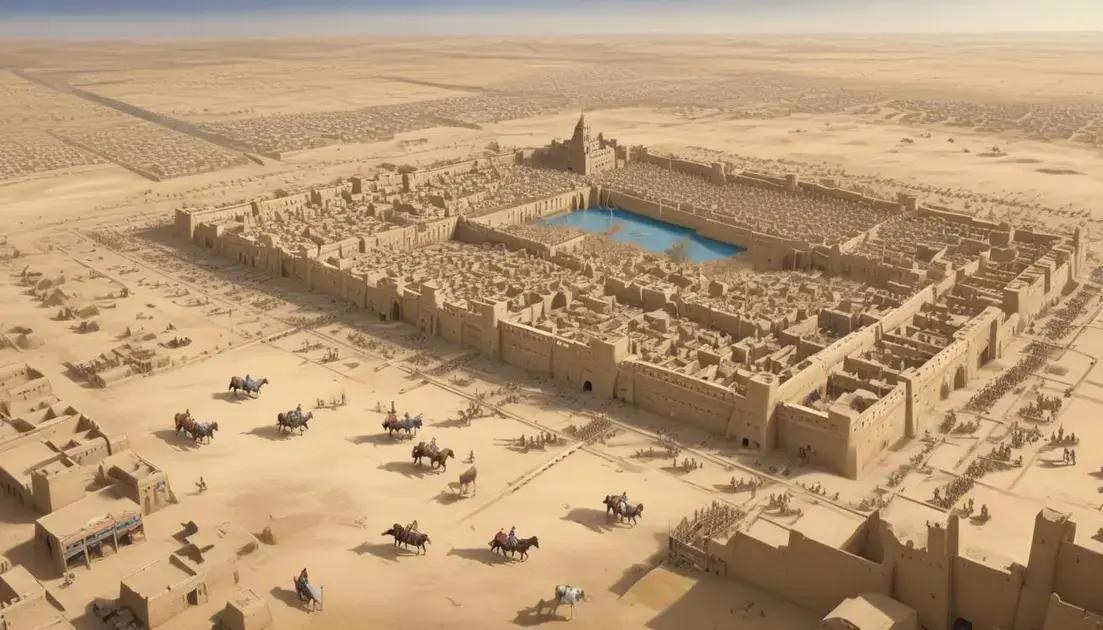
Timbuktu: Intellectual Center of Medieval Africa
Timbuktu, known as a historical intellectual center, thrived due to its prominent libraries and universities that attracted scholars and traders alike. The city’s role in facilitating trade and cultural exchange helped spread knowledge across regions, making it a symbol of learning. Efforts to preserve its rich legacy continue, emphasizing the importance of education and cultural appreciation today.
Timbuktu stands out as a pivotal intellectual hub of the medieval era, shaping the course of learning and trade in Africa. Curious about how a city could be a beacon of knowledge? Let’s explore!
The Historical Significance of Timbuktu
Timbuktu was a major center for trade and learning in ancient times. It attracted scholars and traders from many regions. People came to share knowledge and exchange goods like gold and salt.
Trading Hub
Due to its location, Timbuktu became a vital trading hub on the trans-Saharan trade routes. Merchants would bring their goods from the north and south. This exchange helped spread new ideas and cultures.
Libraries and Knowledge
One of Timbuktu’s most remarkable features was its libraries. These were filled with manuscripts on various subjects like science, medicine, and philosophy. Scholars traveled long distances to study and learn from these texts.
Spread of Islam
Timbuktu played a key role in the spread of Islam across Africa. Many Islamic scholars lived and taught here, making it a center for Islamic learning. People came to learn about religion, law, and ethics.
Enduring Legacy
The historical significance of Timbuktu continues today. Its libraries and cultural contributions remind us of Africa’s rich intellectual history. This city showed how collaboration can foster knowledge and culture.
Trade Routes and Cultural Exchange
The trade routes that passed through Timbuktu were vital for cultural exchange. These paths connected various regions in Africa and beyond. Merchants, travelers, and scholars would share stories and ideas along the way.
Connecting Cultures
Timbuktu served as a melting pot where different cultures met. People exchanged valuable items like spices, textiles, and gold. This blending created a rich cultural landscape.
Sharing Knowledge
Trade was not just about goods; it was also about knowledge. Scholars traveled to Timbuktu to learn from its libraries. They shared their own insights too, contributing to the city’s reputation as a center of learning.
Cultural Influences
As traders moved through Timbuktu, they brought new ideas and practices. This included art, music, and religious beliefs. These influences helped shape the identity of the region.
Impact on Society
The interactions along these trade routes helped build strong communities. People learned to appreciate diversity. They understood how different cultures could enrich their lives.
Timbuktu’s Libraries and Universities
Timbuktu was home to some of the most famous libraries and universities in the medieval world. These institutions attracted scholars from far and wide. They came to learn, teach, and share knowledge.
World-Renowned Libraries
The libraries of Timbuktu housed thousands of manuscripts. These included works on science, astronomy, and literature. Scholars studied these texts, helping to preserve culture and knowledge.
Centers of Learning
Universities in Timbuktu created a space for education and discussion. Students learned from esteemed teachers, gaining valuable skills. They studied various subjects, including mathematics and law.
Impact on Education
The education provided in Timbuktu set a standard for excellence. It helped shape educated leaders in Africa. The city played a vital role in fostering intellectual growth.
Preservation of Knowledge
Many manuscripts from Timbuktu are still being discovered today. These texts provide insight into the past. They tell stories of the city’s vibrant academic community.
Legacy of Timbuktu in Modern Times
The legacy of Timbuktu continues to influence modern society. Its rich history and culture inspire many today. People still admire how Timbuktu thrived as a center of learning.
Global Recognition
Timbuktu is recognized worldwide as a symbol of knowledge. Many see it as a reminder of Africa’s vibrant intellectual past. This helps highlight the importance of education everywhere.
Preservation Efforts
Recent years have seen efforts to preserve Timbuktu’s historical sites. Organizations work hard to protect its manuscripts and buildings. This ensures future generations can learn from its legacy.
Educational Influence
Schools and universities draw inspiration from Timbuktu’s approach to education. They emphasize critical thinking and cultural exchange. This spirit of learning fosters a love for knowledge in students.
Cultural Events
Today, cultural events celebrate Timbuktu’s history. They bring together people from various backgrounds. These events promote understanding and appreciation of the city’s diverse legacy.
Conclusion
In conclusion, the rich history of Timbuktu holds great value for us today. This city stands as a symbol of knowledge and cultural exchange. Its libraries and universities shaped education in Africa and beyond.
Cultural events and preservation efforts keep Timbuktu’s legacy alive. They remind us of the power of learning and sharing ideas. By looking back at Timbuktu, we can inspire future generations to appreciate knowledge and diversity.
Therefore, Timbuktu’s story teaches us to value education and cultural understanding. It helps us realize how the past influences our present and shapes our future.


